We ranked New Jersey's monuments. Here are our top 10
- Oops!Something went wrong.Please try again later.
- Oops!Something went wrong.Please try again later.
When it comes to awe-inspiring monuments, the United States is far from a global leader.
None of the world's 50 tallest statues is in the 50 states, and the collective aversion seems to be growing stronger with time. The creator of one of the three largest statues in America, Zurab Tsereteli, spent nearly seven years trying to offload his 360-foot-tall Birth of the New World statue in the states before he shipped it off to Puerto Rico.
New Jersey, as steeped in history as any of the nation's states, nonetheless holds some significant monuments within its borders. Many were erected decades ago, as public displays of religious, cultural or national pride. In modern times, structural displays of prominence have mostly been left for private enterprise, appreciation and ownership.
That was until 9/11. Dozens of relatively small monuments fashioned from steel salvaged following the Sept. 11 attacks went up throughout New Jersey in the early 21st century. Other more prominent memorials were also placed near the Hudson River. None of those was included for consideration in this list, nor were any other modern memorials.
All 10 of the following monuments are listed on the National Register of Historic Places and ranked in order from "meh" to "whoa."
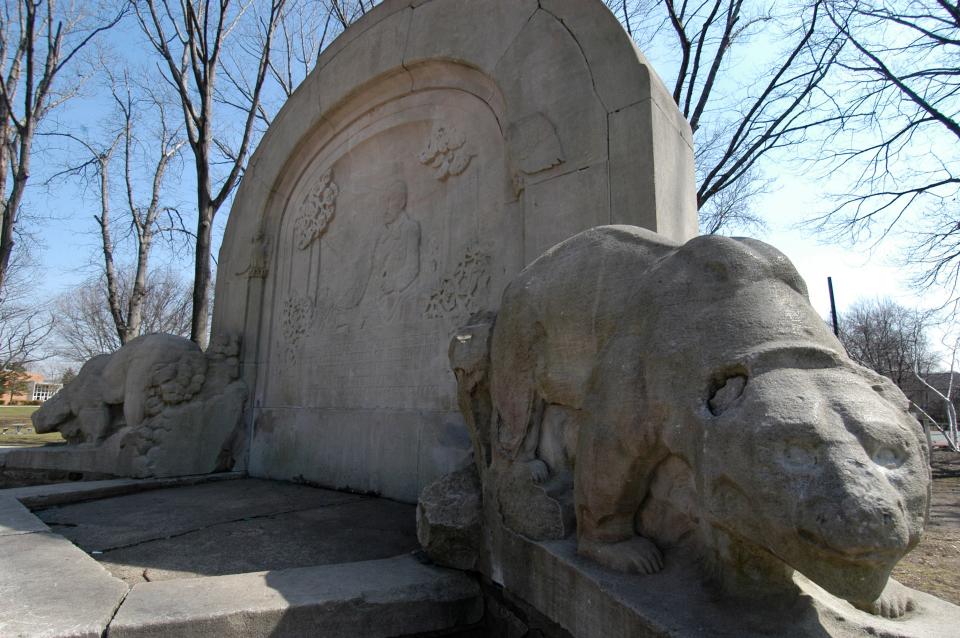
10. Theodore Roosevelt Monument (Tenafly)
Pros: Setting, Bears
Cons: Limestone, Vapid
The Theodore Roosevelt Monument on Riveredge Road in Tenafly honors the 26th president of the United States.
Carved in place from a block of Indiana limestone, the monument was gifted to the local school board by Jennie Mackay and her brother Malcolm Mackay in July 1928. The pair also turned over 30 acres they called Roosevelt Commons to help the community carry out "the Roosevelt ideal of training boys to be physically, mentally and morally fit," The Record reported that month.
The two-sided sculpture stands 14 feet tall and depicts Roosevelt among various animals and birds. The designer, sculptor Trygve Hammer, and his assistant, Fritz Hammargren, included life-sized sculpted bears on both sides. The namesake of fuzzy toy bears, Roosevelt advocated for eugenics. environmental conservation and tax reform.
The monument underwent a $125,000 restoration in 2021 to reverse the effects of weathering and vandalism.
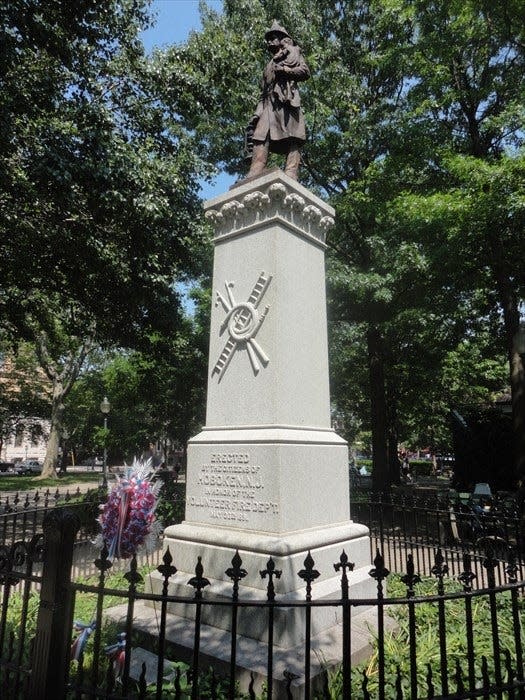
9. Firemen's Monument (Hoboken)
Pros: Old-school-charm, Crowdsourced
Cons: On-the-nose, Small
The Firemen's Monument, cast in bronze by J. W. Fiske & Company of New York City, keeps tradition alive in a Hoboken park packed with modern-day amenities.
Standing on Church Square Park's west end near Willow Avenue, the monument is topped by an 8-foot statue of a fireman carrying a small child in one arm and suspending a lantern from the other. An ornate granite pedestal allows the monument to measure roughly 28 feet tall.
Firemen's Monument was dedicated by the city's citizens to their volunteer Fire Department in May 1891. The following month, city officials established Hoboken's first paid fire department.
Residents established the volunteer department in 1848 in response to Hoboken's late 1840s population growth and an 1847 lighting strike that burned two Washington Street homes. With donations, locals funded a fire engine and a firehouse that allowed 66 men to form Engine Co. #1.
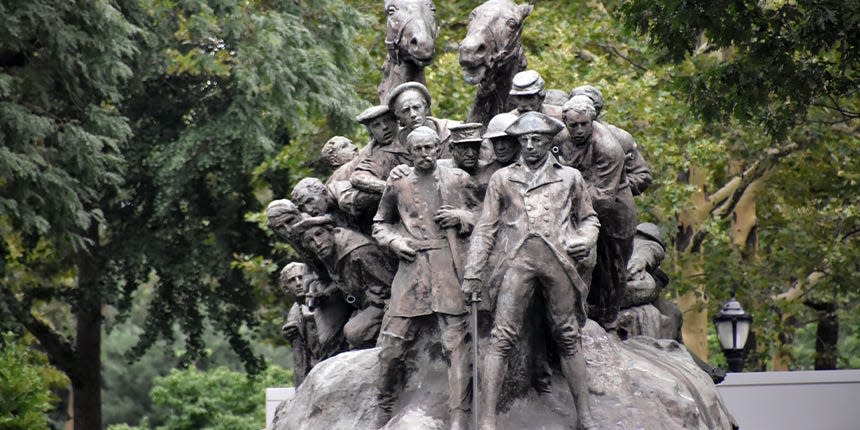
8. Wars of America (Newark)
Pros: Borglum, Broad themes
Cons: Borglum, Vantage points
Designed to be the largest bronze monument in the United States, Wars of America was the creation of controversial Mount Rushmore sculptor Gutzon Borglum, who designed several other Newark sculptures in the early 20th century.
Wars of America was dedicated in May 1926 to honor the heroes who participated in the conflicts of 1776, 1861, 1898 and 1917. It was primarily funded by city businessman Amos Hoagland Van Horn, who allocated $100,000 of his estate for the project in his 1908 will.
The memorial depicts two horses and 42 people in various states of motion linked to tales of military action. Among them is Van Horn as he was in 1861, a young Union Army volunteer.
The granite base comes from Georgia's Stone Mountain, where Borglum infamously worked on a massive Confederate Army monument. The bronze was cast in Florence, Italy in 1925 in a cost-saving measure. All in, it stands 42 feet long, 18 feet wide and 17 feet high. From above, the mass appears as the hilt of a sword in the overall design of Newark's Military Park.
7. World War I Monument (Rutherford)
Pros: Local ties, Accessible
Cons: Cast stone, Plain
Standing in the aptly named Memorial Circle, the World War I Monument in Rutherford honors 19 soldiers who fought and died in the conflict.
The monument was designed by Rutherford architect Edgar Williams, the notable but now lesser-known brother of poet William Carlos Williams, and dedicated in May 1920.
Impressive but not imposing, it stands at 32 feet and 10 inches tall. It features a pedestal with an octagonal base topped by a Tuscan column supporting a bronze lantern replete with flame globe. Mostly cast stone, the monument has some bronze ornamentation. That includes the plaques denoting the deceased soldiers and battle locations.
Though it has seen major restoration work since 2013, the monument is little altered. It stands at a five-way intersection near the town's post office, municipal building and library. The latter was also designed by Williams, who died in 1974.
6. Thomas Alva Edison Memorial Tower (Edison)
Pros: Sound system, Height
Cons: Glass ball, Art Deco
The Thomas Alva Edison Memorial Tower dominates the famous inventor's 1876 industrial research complex.
A concrete monolith clad in precast concrete facing dusted with quartz and ceramic aggregate, the tower is a 135-foot-tall Art Deco beacon. It is topped by a light bulb made of 153 pieces of amber-tinted Pyrex that is reminiscent of something that would descend over Times Square on New Year's Eve.
The structure contains more than 50 tons of reinforced steel and was formed by 1,200 barrels of Edison Portland brand cement. It also has a built-in RCA-Victor sound system and a replica of Edison's first incandescent lamp.
Dedicated in February 1938, the memorial tower was designed by Massena & duPont, Architects, who also created Wilmington, Delaware's Memorial Carillon Tower. It was a roughly $134,200 gift from William Slocum Barstow to the Thomas Alva Edison Foundation. The sound system cost extra.
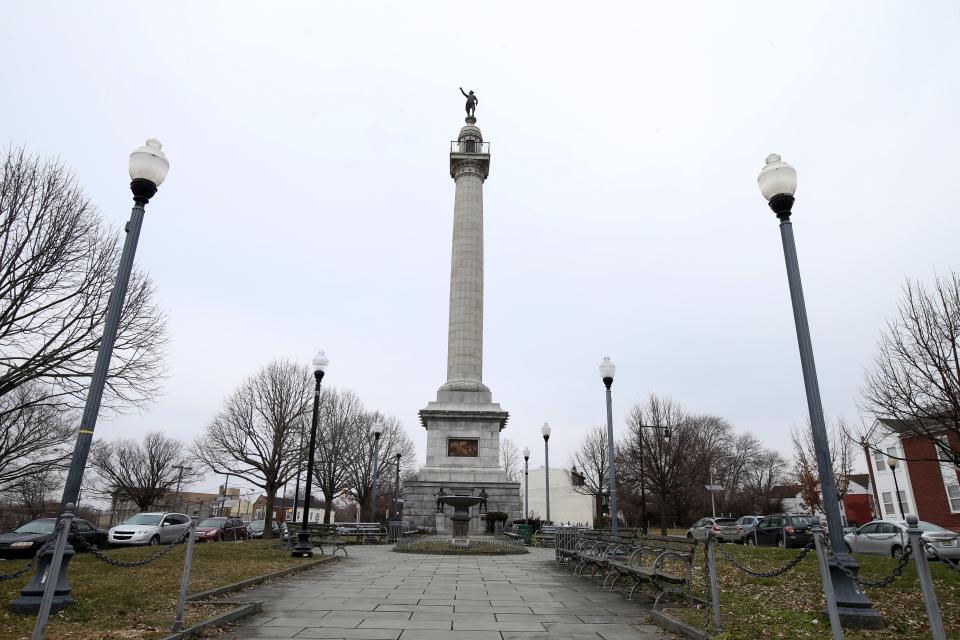
5. Trenton Battle Monument
Pros: Roadside, Tall
Cons: Traffic, Out-of-order
The Trenton Battle Monument is a massive Doric column towering 150 feet above Route 206.
Classically ornate, the monument is mainly carved granite decorated with various classical Greek moldings
Positioned on what historians considered the site of General George Washington's main gun fortifications during the Battle of Trenton, the pillar is topped by a statue of Washington crafted by William O'Donovan, a 19th-century sculptor of monuments, busts and base reliefs in the New York area. Just below the statue rests an observation deck once accessed by an iron ladder and, later, a now out-of-order Otis elevator.
The Thomas Eakins bronze plaques on the bottom show Washington's famed Delaware River crossing, the first shots of the battle in December 1776 and the surrender of the Hessians. Funded by private citizens, government allocations and Trenton Battle Monument Association fundraisers, the monument was dedicated in October 1893 - exactly 112 years after the British surrender at Yorktown.
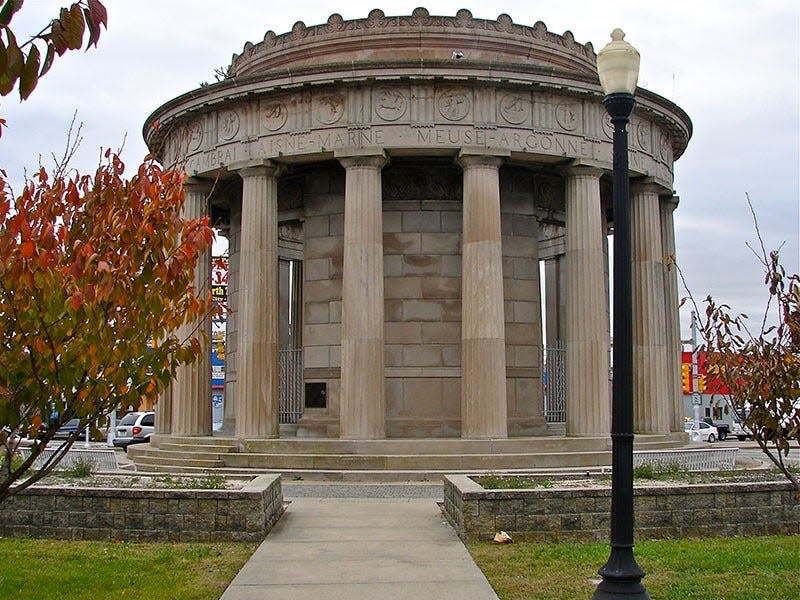
4. World War I Memorial (Atlantic City)
Pros: Multifaceted, Location
Cons: Unoriginal, Noise
A temple supported by Indiana limestone columns surrounding an elegant bronze statue atop green marble, the World War I Memorial represents a plan repurposed.
Germinated from a 1907 Atlantic City improvement plan called "City Beautiful," the monument and its 16 Doric columns started as a Greek-style temple meant to provide the tourist destination with some curb appeal. As such, it was placed at the busy intersection of Ventnor and Albany avenues.
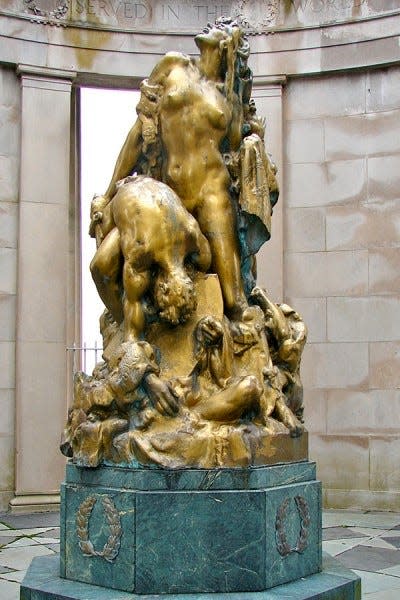
Finally realized by city officials 16 years later, the stone temple cost the city $93,000 when it was built in 1923. The bronze, depicting a personification of Liberty surrounded by the dead, came in 1929 at a cost of $19,000. The octagonal Vermont marble base brought a $3,200 price tag.
The Frederick MacMonnies designed sculpture, titled "Liberty in Distress," was meant to be exclusive when commissioned by city officials. It was, however, the same design he submitted for a monument to commemorate the end of World War I. Called the American Monument, that stone statue stands in Meaux, France.
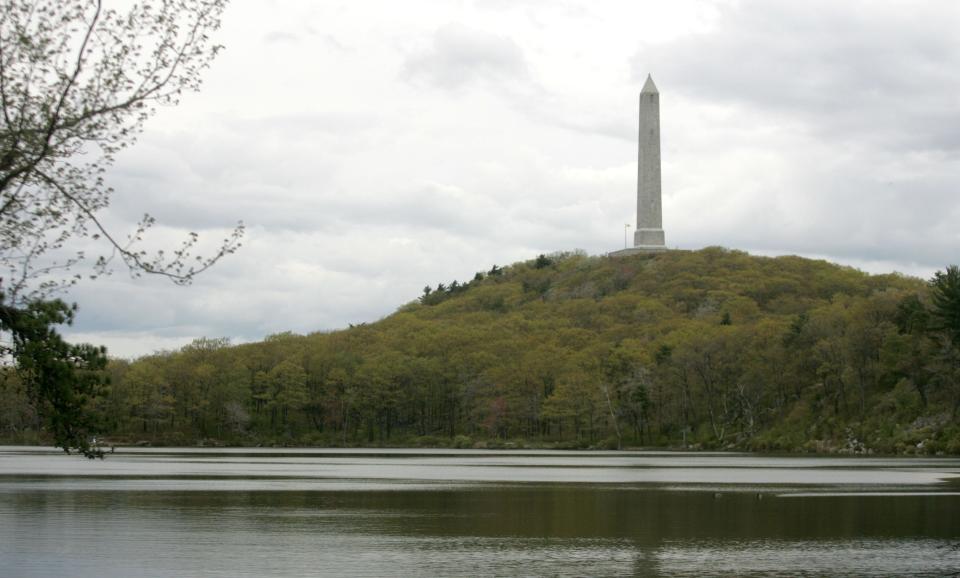
3. High Point Monument
Pros: A view, 220 feet
Cons: A hike, 291 steps
The stone tower in High Point State Park is simple. It is nonetheless striking.
Perched atop New Jersey's highest point, the 220-foot-tall High Point Monument was a $256,000 gift to the state from Colonel Anthony Kuser and Susie Dryden Kuser. The pair in 1923 donated the surrounding 10,000 acres to the state for the park's creation. They wanted to save the highest point for a tribute to the state's soldiers.
Designed in the style of an ancient Egyptian obelisk, the tower is a rough copy of the Bunker Hill Monument in Boston. It is clad in heavily textured granite and features an inner chamber and an observation deck. With a beacon created by the Westinghouse Company, the tower cost the colonel and his wife $256,000.
State officials ruled out a 1952 proposal to install an elevator, after finding the tower's vantage point provides little utility for forest fire observation. Those craving the view must climb 291 steps to the top. They can, however, skip hiking the scenic 1.5-mile trail to the tower by driving to the tower's base.
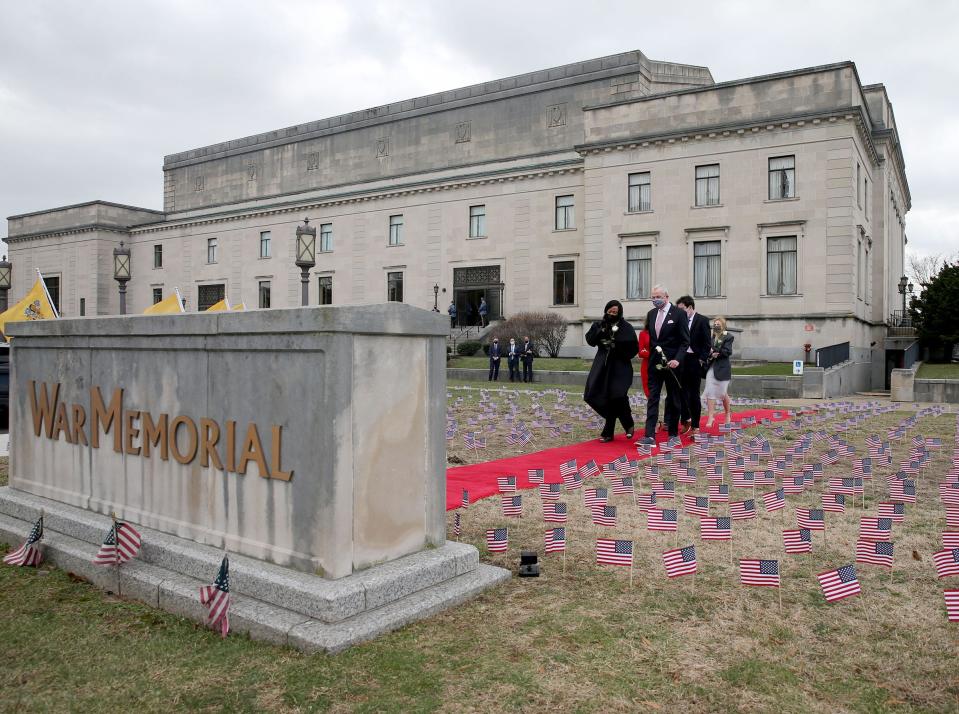
2. Trenton War Memorial
Pros: Multi-use, Large
Cons: Utilitarian, Squat
Devised in the wake of World War I, the Trenton War Memorial pays tribute to the soldiers of Mercer County.
The Indiana limestone monument was the brainchild of the city's War Memorial Committee, essentially an expanded version of its wartime War Emergency Committee. The group wanted the memorial to bring beauty to the city, dignity to its veterans and civic utility to its residents.
A civic and performing arts center in the Italian Renaissance revival style, the $927,000 project on the Delaware River was led by Louis Kaplan, a city architect and war veteran. Kaplan included hints of Art Deco design throughout the building in his effort to marry form and function.
Included in the memorial are a memorial court paved in pink marble, an assembly hall that can hold a banquet for 500 and a 2,000-seat auditorium once replete with golden mohair seats. The memorial also has offices and meeting rooms created for state American Legion and Veterans of Foreign Wars officials.
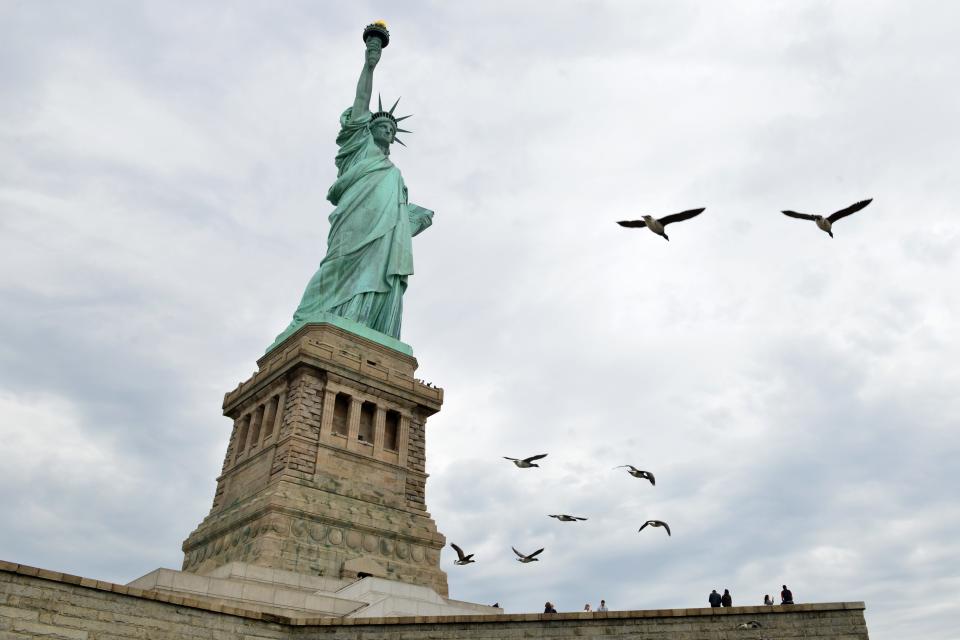
1. Statue of Liberty National Monument
Pros: Enormous, Icon
Cons: Unoriginal, Island
The Statue of Liberty National Monument's size is only overshadowed by its symbolism.
A standout in New Jersey waters, the 152-foot bronze statue sits atop a 65-foot-tall concrete foundation and a granite-faced pedestal that adds another 43 feet.
French sculptor Frederic Auguste Bartholdi created the monument as an enlarged version of "Liberty Enlightening the World" to commemorate a sense of friendship and alliance between France and the United States. Paid for with French fundraisers, the statue is exponentially more popular than other Garden State memorials in spite of its inconvenient island location.
The monument was dedicated in October 1886, more than a decade after construction began in France and more than a year after the disassembled statue arrived in 214 crates. The statue was rebuilt on site from 300 copper sheets nearly 1/10th of an inch thick and backed by iron strips. The strips were attached to a framework designed by Alexandre Gustave Eiffel that allows visitors to reach vantage points over New York Harbor at the top of the statue.
This article originally appeared on NorthJersey.com: We ranked New Jersey's monuments. Here are our top 10

